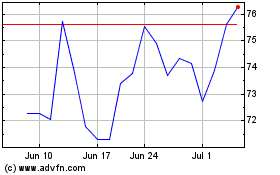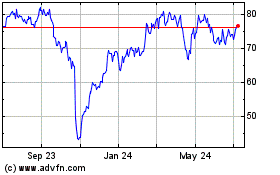Debt Consolidation Often Results in Higher Credit Scores and Better Credit Performance
October 30 2019 - 7:00AM

Participation in the consumer lending market is at a record high,
with more than 19.6 million consumers carrying an unsecured
personal loan through the first half of 2019. Consumer adoption of
personal loans for debt consolidation has driven much of this
growth, as consumers with heavy credit card debt often receive
offers to consolidate their debt via a personal loan. However, the
increased prevalence of consolidation loans has led to the rising
misconception that this practice may lead to a debt trap for
consumers.
TransUnion (NYSE: TRU) released findings today at Money
20/20 USA from their recent study exploring how debt consolidation
loans impact consumer credit performance, overall debt load and
credit health. The study found that many consumers benefit from
accepting these offers –and perform better on those products –
over the long-term.
“We are seeing a shift in consumer credit preferences toward
streamlining bills into a single monthly payment. Personal loans
offer a predictable payment plan with set terms and fixed rates,”
said Liz Pagel, senior vice president and consumer lending business
leader at TransUnion. “Consumers with credit card debt often have
to juggle multiple payments on several cards. Not only does debt
consolidation make paying bills more simple, but more importantly
it often results in a credit score boost for some individuals.”
The study found that, on average, consumers who take on a debt
consolidation loan pay down just over 58% of their credit card debt
with the new personal loan, bringing average credit card balances
down from $14,015 to $5,855. Over 60% of consumers who
consolidated their credit card debt saw their balances decline by
60% or more from pre-consolidation levels. The resulting drop in
credit line utilization, among other factors, led to a boost in
credit scores for the majority of consumers who employed a debt
consolidation loan.
Following consolidation, 68% of consumers saw their credit
scores improve by more than 20 points. Score migrations were
consistent across all risk tiers, but most notably the prime and
below risk tiers possessed the greatest percentage of consumers
with improved credit scores. While the initial score boosts were
apparent after just one quarter, the results were not short-lived.
Score improvements persisted a year later (albeit at lower
levels).
Debt Consolidation Drove Score
Improvements Across All Risk Tiers
|
Score Migration BOP to EOP +3 months |
Segment |
Subprime |
Near Prime |
Prime |
Prime Plus |
Super Prime |
|
Improved(+20 pts.
or more) |
Control |
35 |
% |
22 |
% |
18 |
% |
13 |
% |
1 |
% |
|
Debt Consolidators |
84 |
% |
77 |
% |
68 |
% |
51 |
% |
15 |
% |
|
Same(-19 to +19
pts.) |
Control |
46 |
% |
60 |
% |
63 |
% |
70 |
% |
83 |
% |
|
Debt Consolidators |
14 |
% |
20 |
% |
26 |
% |
39 |
% |
73 |
% |
|
Worsened(-20 pts. or less) |
Control |
19 |
% |
18 |
% |
19 |
% |
16 |
% |
13 |
% |
|
Debt Consolidators |
2 |
% |
3 |
% |
6 |
% |
10 |
% |
12 |
% |
*VantageScore 3.0 risk ranges: Subprime= 300-600;
Near Prime= 601-660; Prime= 661-720;Prime Plus= 721-780; Super
Prime= 781-850
Strong performance following debt
consolidation
These consumers’ higher credit scores may make them more
attractive to lenders, which in turn leads to them receiving more
offers for credit and ultimately to greater new credit
originations. Not only were these borrowers more likely to obtain a
new auto loan or credit card following consolidation, they also
originated mortgages at a higher rate within the following 12 month
period.
Despite a rise in overall indebtedness, consolidators performed
significantly better than non-consolidators on all credit products
in their wallet, even when controlling for credit risk score. In
the year following consolidation, consolidators showed fewer past
due accounts than non-consolidators, and in particular had a lower
serious delinquency rate—defined as 90 or more days past due
(“DPD”)—on credit card accounts. In addition, debt consolidation
loans performed better than personal loans used for other purposes.
In the prime risk tier, debt consolidation loans had a serious
delinquency rate (defined as 60+DPD for this product) of 1.1%
compared to 2.4% for loans used for other purposes.
“The question surrounding debt consolidation is whether these
loans are enabling consumers to take on more debt than they can
handle. While these consumers do end up taking on more debt
initially, our research shows debt consolidation loans do have a
positive impact on consumer performance. A personal loan used for
debt consolidation tends to be a better performing loan overall. In
short, debt consolidation loans generally appear to do what they’re
designed to do, and that’s a benefit to consumers,” concluded
Pagel.
For more information on TransUnion’s Debt Consolidation Study,
please download the informational quick guide.
About TransUnion (NYSE: TRU)Information is a
powerful thing. At TransUnion, we realize that. We are dedicated to
finding innovative ways information can be used to help individuals
make better and smarter decisions. We help uncover unique stories,
trends and insights behind each data point, using historical
information as well as alternative data sources. This allows a
variety of markets and businesses to better manage risk and
consumers to better manage their credit, personal information and
identity. Today, TransUnion has a global presence in more than 30
countries and a leading presence in several international markets
across North America, Africa, Europe, Latin America and Asia.
Through the power of information, TransUnion is working to build
stronger economies and families and safer communities
worldwide.
We call this Information for Good.®
http://www.transunion.com/business
|
Contact |
Dave
Blumberg |
| |
TransUnion |
| E-mail |
david.blumberg@transunion.com |
| Telephone |
312-972-6646 |
TransUnion (NYSE:TRU)
Historical Stock Chart
From Mar 2024 to Apr 2024

TransUnion (NYSE:TRU)
Historical Stock Chart
From Apr 2023 to Apr 2024
